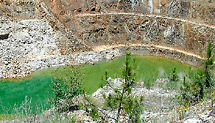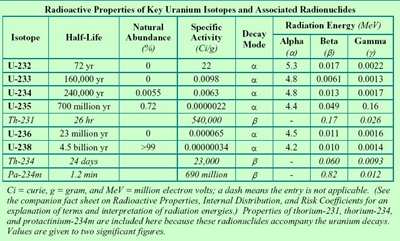Learn how uranium is mined and milled.
Mining

There are three forms of uranium mining: open pit mining, deep mining; and in situ leaching.
Open pit mining creates large holes dug into the ground to remove the ore and waste rock which impedes ore extraction. This method is frequently used when the desirable ore is close to the surface. The mining operation planned in Pittsylvania County in the 1980s would have been a 110-acre hole, 850 feet deep. Deep mining creates shafts dug into the ground to reach ore at deeper levels. In the last decade, in situ leaching has become more widely used. In situ leaching uses a solution that is injected into underground uranium deposits to extract the uranium from the other minerals. The liquid, now pregnant with uranium, is pumped to the surface where the uranium is taken out of the solution. This process is repeated until all of the uranium is extracted.
Milling
Uranium milling involves extracting uranium from mined ore. The ore is crushed into sand size particles and the uranium is leached out. The uranium then is precipitated out of the leaching solution and dewatered, dried, and packaged. Through the extraction process, uranium is concentrated into a product referred to as "yellowcake." In situ leaching is a combined mining and milling operation.
Tailings
Enormous quantities of radioactive waste are generated by uranium mining and milling, with only 2 to 4 pounds of concentrated uranium oxide yellow cake obtained from each ton of ore taken out of the ground. The resulting waste, or tailings contain 85% of the original radioactivity and remain radioactive for hundreds of thousands of years. Tailings can contain several hazardous substances, including radium (which decays to produce radon) selenium, molybdenum, uranium, and thorium. The mill tailings and the mill tailings effluent are highly radioactive and acutely hazardous. Dr. Doug Brugge, of the Tufts School of Medicine, testified before Congress and described uranium ore "as a toxic brew of numerous hazardous materials." Read more of Dr. Brugge's testimony.
According to the Environmental Protection Agency's Technologically Enhanced Naturally Occurring Radioactive Materials (TENORM) document, most tailings piles are located in arid areas of the western U.S where low precipitation decreases the potential for water contamination.
Still, even in the arid West, there are problems with water management around uranium mines. Because uranium and other radioactive materials are soluble in surface and ground water, the EPA has stated that water is probably the most significant means of dispersal of uranium and technically enhanced naturally occurring radioactive materials from mines and mine wastes. Water coming into contact with these wastes must therefore be treated or contained – millions of gallons of water for thousands of years.
 |
| Radioactive Properties of Key UraniumIsotopes, U.S. Department of Energy, Argonne National Laboratory, EVS, August 2005. |
